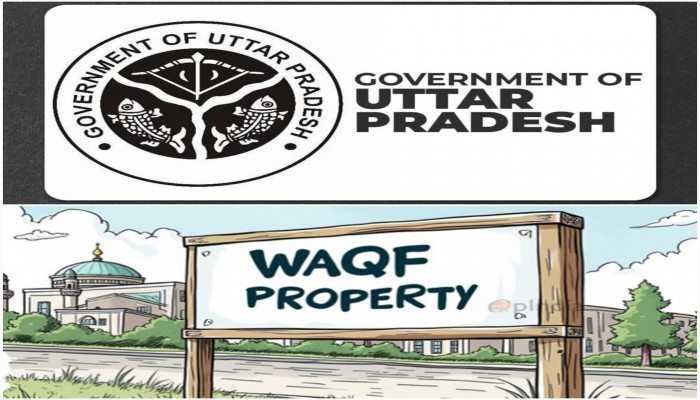Waqf board claims over 57,000 government properties across UP: Survey report
- In Reports
- 06:45 PM, Feb 07, 2025
- Myind Staff
The unauthorised occupation and claims over properties belonging to both private individuals and the government by Waqf Boards have become a major issue in several states across India. Many properties, ranging from vast land areas in different districts of Uttar Pradesh to even entire villages in Tamil Nadu, have either been illegally taken over or arbitrarily declared Waqf property.
According to a report by the Joint Parliamentary Committee (JPC), which compiled district-wise data on Waqf properties in Uttar Pradesh, the highest number of illegal Waqf properties on encroached government land have been recorded in Ayodhya, Shahjahanpur, Rampur, Jaunpur, and Bareilly. As per Amar Ujala, each of these districts has at least two thousand or more properties that Waqf boards have claimed, despite these lands being categorised as public-use property in official revenue records. The JPC has submitted its report to Lok Sabha Speaker Om Birla, highlighting these widespread encroachments.
According to the records of the Waqf Board, Shahjahanpur has 2,589 registered waqf properties, of which 2,371 are situated on government land. Similarly, in Rampur, 2,363 out of 3,365 waqf properties are located on government-owned land. In Ayodhya, 2,116 out of 3,652 properties registered as waqf belong to the government. Jaunpur has 2,096 out of 4,167 such properties on public land, while in Bareilly, 2,000 out of 3,499 waqf properties are built on government land.
According to Amar Ujala's report, 57,792 government-owned properties across Uttar Pradesh have been recorded as Waqf properties in the Waqf Board’s official records. The claim of Waqf ownership over government land has been identified in the top 21 districts of the state. The Joint Parliamentary Committee (JPC) report highlights specific figures for some of these districts, revealing that Lakhimpur Kheri has 1,792 such properties, followed by 1,778 in Bulandshahr, 1,610 in Fatehpur, 1,581 in Sitapur, and 1,575 in Azamgarh.
Other districts with significant numbers include Saharanpur (1,497), Moradabad (1,471), Pratapgarh (1,331), Agra (1,293), and Aligarh (1,216). Additionally, Ghazipur (1,251), Meerut (1,154), Sambhal (1,150), Amroha (1,045), Deoria (1,027), and Bijnor (1,005) also have government properties that have been registered as Waqf land. These findings indicate widespread unauthorised “Waqf property” on government land.
A government report has identified 40 districts in Uttar Pradesh where numerous waqf properties are registered with the waqf boards, but there is no official record of property transfers in tehsil records. The districts include Firozabad, Mainpuri, Mathura, Aligarh, Etah, Kasganj, Ayodhya, Azamgarh, Ballia, Badaun, Shahjahanpur, Siddharthnagar, Bahraich, Balrampur, Gonda, Shravasti, Deoria, Kushinagar, Maharajganj, Jalaun, Lalitpur, Auraiya, Farrukhabad, Kannauj, Kanpur Dehat, Hardoi, Rae Bareli, Bulandshahr, Ghaziabad, Hapur, Bhadohi, Mirzapur, Sonbhadra, Bijnor, Kaushambi, Prayagraj, Chandauli, Jaunpur, Varanasi, and Mahoba.
Interestingly, in Mahoba, the waqf board has no records of waqf properties, while Sonbhadra has only one officially recognised waqf property. However, the district gazette lists 245 properties in Mahoba and 171 in Sonbhadra as waqf properties, highlighting discrepancies in official records.
Additionally, a government-ordered survey in Kanpur last month revealed the existence of 1,670 waqf properties in the district. Out of these, 548 properties have been constructed on government land. The survey further detailed that in Kanpur’s Sadar tehsil, 914 properties fall under the Sunni Waqf Board, while 34 are under the Shia Waqf Board.
Other areas, such as Ghatampur, have 189 waqf properties, Bilhaur, 388, and Narwal, 144. The report also noted that a significant majority, 80% of these illegal waqf properties, are being used for Islamic religious purposes, with many of them consisting of mosques, graveyards, shrines and mausoleums built on encroached government land.
State governments have been conducting surveys to identify waqf properties. A recent study in Rajasthan revealed that government records list 69 temples, most of them ancient, under the ownership of the Waqf Board. These temples are primarily located in Bharatpur, Jhalawar, and Alwar and are spread across 59 waqf properties in 20 state districts.
In December 2024, the Central government reported 8.72 lakh waqf properties across India. Of these, 994 properties were found to have been illegally transferred to waqf. Tamil Nadu accounts for the highest number, with 734 cases, while Rajasthan has 63 illegally transferred waqf properties. The government also informed Parliament that out of the 8.72 lakh waqf properties, only 3.3 lakh have been digitised, which means just 37% of these properties are currently recorded in the digital database.







Comments